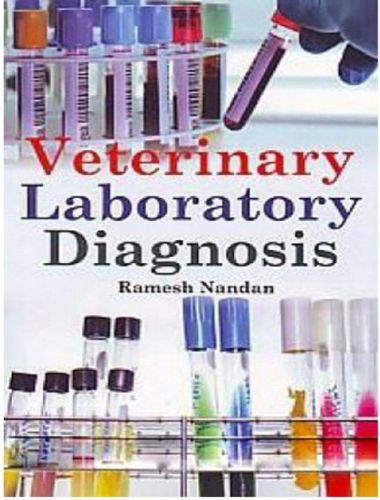Veterinary Laboratory Diagnosis
by Ramesh Nandan

This book is designed to indicate which tests are most clinically useful for the dog, cat, horse, and ruminant, with suggestions for diagnostic applications and interpretations of results. Students of veterinary science and animal health practitioners will this book valuable in their study and practice.
Laboratory Diagnosis or Clinical pathology is a sub specialty of pathology that deals with the use of laboratory methods (clinical chemistry, microbiology, hematology and emerging sub specialties such as molecular diagnostics) for the diagnosis and treatment of disease. Just as your physician will check your vital signs, weight, and other conditions when you visit the doctor, veterinarian will also want to check vital signs and obtain basic medical information about pets and livestock.
In addition to checking pet’s weight, looking at pet’s eyes, checking its ears, routine examination of the mouth and teeth, and observing the pet’s movements, there are other simple tests that are often performed. The veterinarian will use a stethoscope to listen for abnormal heart, lung, or digestive system sounds that may indicate problems with these organs.
The veterinarian may gently press on the pet’s gums with a finger and then release the pressure to determine how long it takes for the capillaries in the gums to refill. A longer than normal capillary refill time may indicate that the pet is going into, or is already in, shock. Long refill times also occur in certain heart diseases. The colour of the gums can also indicate problems such as jaundice (a sign of liver disease), shock, or anemia.
Veterinarians use their hands to check for the size and location of internal organs such as the liver, spleen, kidneys, and urinary bladder. This is called abdominal palpation. They will also check for enlargement of lymph nodes located throughout the body. If the pet has a specific problem at the time of the examination, the veterinarian may perform additional tests that are not generally part of a routine physical examination.
For example, examination of a dog with suspected vision problems might include tests that assess overall vision, examination with an ophthalmoscope and various stains, and determination of the pressure within the eye. Similarly, examination of a lame horse might include a hands-on examination of the affected leg, blood and biochemical tests, muscle biopsy, and various types of imaging techniques.
Early warning is the rapid detection of the introduction of, or sudden increase in, any disease of livestock which has the potential of developing to epidemic proportions and/or causing serious socio-economic consequences or public health concerns. It embraces all initiatives and is mainly based on disease surveillance, reporting and epidemiological analysis. These lead to improved awareness and knowledge of the distribution and behaviour of disease outbreaks and infection, allow forecasting of the source and evolution of the disease outbreaks and the monitoring of the effectiveness of disease control campaigns.
Download: Small Animal Spinal Disorders: Diagnosis and Surgery 2nd Edition
The rapid and accurate diagnosis of diseases can only be assured in fully equipped laboratories that have a range of standardized diagnostic reagents, experienced staff and a sufficient throughput of diagnostic specimens to maintain expertise. It should be noted that development of diagnostic expertise for exotic disease using tests that require handling the live agent should only be attempted in micro biologically high-security laboratories.
Laboratory diagnostic procedures should not be done without prior detailed clinical-epidemiological investigations as otherwise the lab results will be too undetermined. It is important to always include the entire herd and also to bear in mind that the unborn animals play a significant role with regard to the chain of infection. In other words, it pays off to plan for the long term – i.e. to include the age structure and the pregnant animals in all considerations.
Direct Link For Paid Membership: –
